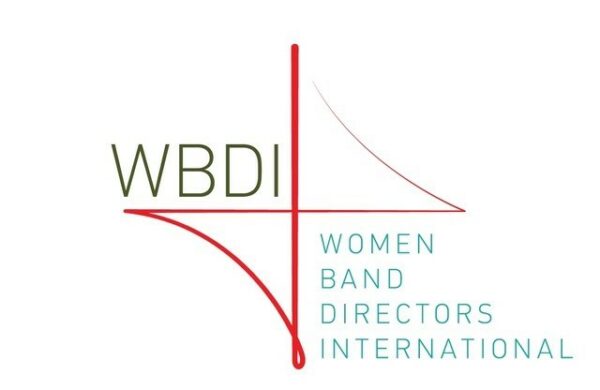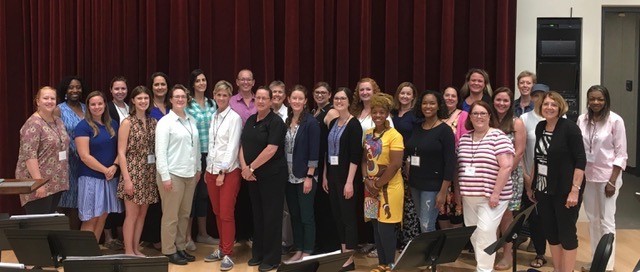/ News Posts / Women with Batons Band Together
Women with Batons Band Together
Launched at a time when women rarely worked outside the home, Women Band Directors International is celebrating 50 years of mentoring and supporting women in the field.
By NAfME Member Lori Schwartz Reichl
This article first appeared in the January 2020 issue of Teaching Music.
In 1967, Gladys Stone Wright had one question: “Where are the women?”
A master educator and conductor, Wright wanted to know where other women band directors were located in the United States, who they were, what challenges they faced, and how they overcame them. Reminiscing, she states, “I wanted to meet the women. I wanted to give the women experience in leadership through writing articles, hosting conventions, running professional organizations, mentoring, and just having fun being together and sharing experiences.” She was inspired to form an organization that promoted and served women in her field.
The organization’s vision began at the Daniel Boone Music Camp in Kentucky in 1967 where a meeting to discuss coordinating a women’s band organization was attended by six of the women enrolled in the summer camp. At the Midwest Clinic in December 1968, five women met and drafted a temporary constitution and divided the slate of officers among themselves, launching the Women Band Directors National Association. The year 1969 was spent locating women band directors, writing to them, and promoting the organization throughout the United States. All those who joined the organization in 1969 received charter status, and the first slate of elected officers was selected in 1971. After 25 years, the organization expanded to include women from Canada and other countries and changed its name to Women Band Directors International (WBDI).
“By uniting and working together, we are able to help each other in many ways—socially and professionally.”—Gladys Stone Wright
As the founding president of the Women Band Directors National Association and founding editor of the organization’s journal, The Woman Conductor, Wright has led bands to superior performances locally, regionally, and internationally. In 36 years of teaching at several high schools in Oregon and Indiana, her bands performed at a number of music education events and conferences, including the Midwest Clinic and the International Band and Orchestra Conference in Chicago in 1960, and were known for their traveling tours throughout North America and Europe. In 1975, her band won the Gold Medal at the World Music Contest in Kerkrade, Holland. Wright is the first woman band director elected to the American Bandmasters Association and the National Band Directors Hall of Fame of Distinguished Band Conductors.
In 2019, WBDI celebrated 50 years of representing women band directors at all pedagogical levels from college students to retired directors, including women with a wide range of teaching and directing experience. It is the only international organization for women band directors created to promote women, provide support and community for women, and mentor women in the band field. Its purpose is to foster a spirit of fellowship, equality, support, and mentorship for all women, their students, and school communities globally.
WBDI commemorated its 50th anniversary at the Midwest Clinic in December 2019 with a member luncheon and presentation titled “Celebrating 50 Years of Women Conductors: Our Trailblazers, the Present, the Future.” Honored presenters included Virginia Allen, Susan D. Creasap, Barbara Lambrecht, Catherine Rand, Courtney Snyder, and Gladys Stone Wright. The presentation recognized and thanked the inspirational and influential women band directors who paved the way for women standing on podiums today. Snyder recalls, “It also provided an opportunity to discuss the present and future of WBDI and how we can learn front the past, support each other intergenerationally, and continue to build and strengthen the community of women band directors.”
Catherine Rand, WBDI immediate past president, serves as director of bands and associate professor at the University of Southern Mississippi in Hattiesburg. “What makes WBDI unique is that it brings band directors from all levels together with a wide variety of experience,” she says. “It breaks down the barriers between generations and allows us all to discuss what we do in our positions, support one another, and share perspectives from a woman’s viewpoint.”
One of Rand’s fondest memories as a WBDI member is presenting a conducting session at a summer conference for WBDI. “Afterwards, about six women approached and asked if I would help them with their conducting. It was beneficial to immediately go beyond the clinic to continue professional development. It was a nurturing environment that was not competition-driven and was a welcoming moment for all directors to refine our craft.”

WBDI Members Participate in the Summer Conference at DePaul University in Chicago, July 2019. Photo courtesy of MJ Robinson, WBDI Curator of Historical Information
Courtney Snyder, associate director of bands and assistant professor of conducting at the University of Michigan in Ann Arbor, serves as WBDI president and greatly enjoys being a member of the organization. Through this community, she says she has had the pleasure of “gaining perspectives from people with similar and dissimilar life and occupational experiences and encouraging and promoting the great work of other women.”
Snyder appreciates “being part of something that is inclusive of all women irrespective of what type of band directing position they have.” She is grateful for “having an opportunity to communicate and build relationships with women from across the country, from different generations, and who teach at different levels from elementary to college and military.” Like Rand, Snyder believes the WBDI Summer Conference is one of the most beneficial aspects of the organization. “It is a place where I’m completely focused on the event, building relationships with other women professionally and recreationally, and learning from other women.”
Jill Sullivan, professor of music education at Arizona State University in Tempe, serves as WBDI history chair, and her research includes investigations of 19th- and 20th-century women’s bands and music teacher education. In her 2008 Music Educators Journal article “A Century of Women’s Bands in America,” Sullivan encouraged educators to research the history of their school’s music programs by discovering who served as previous directors and what ensembles may have existed solely for women. In addition, she extends “a call to public school band teachers to look into their school’s historical archives to see if and when women were conductors, who participated in the program, and whether bands were divided by gender.”
Sullivan notes that women’s bands are an aspect of America’s history worth sharing with students and researching locally. The golden age of town bands existed from approximately 1870 to 1920, a period that included all-women’s town bands. Educators can use this knowledge as a teaching tool by creating a history lesson about the school’s band program (or the local town or city’s band), including former directors and members.
Judith E. Grimes, professor emeritus at Elmhurst College in Elmhurst, Illinois, is a WBDI charter member, past president, mentoring chair, and recent Hall of Fame awardee. Grimes says the WBDI consists of “dedicated women sharing similar challenges and professional goals, but also becoming friends and family along the way.” Grimes says the job of band director is hard to do well regardless of gender.
“Changes are a part of the challenges,” says Grimes. “Busy, productive women are involved in many different facets of life. Psychologists say that women ‘flow’ and men ‘compartmentalize.’ It is the flowing through children, families, professional obligations, and meeting the daily obligations of the school systems that women can celebrate together.” They also share ideas with each other to the benefit of all.

WBDI Members Amanda Burdette, Shannon Shaker, Lori Schwartz Reichl, Robyn Bell, and MJ Robinson in Chicago, July 2019. Photo courtesy of MJ Robinson, WBDI Curator of Historical Information
WBDI founder Wright recalls that during much of her extensive career, “Women rarely worked out of the home. We felt like we could marry after we had worked a while in our profession, but eventually we would have to quit and follow the social norms. As a band director, it was difficult to combine even marriage and a career, let alone a family.” Wright is thrilled to know that many women who choose to do so today are able to have both a family and a career. “By uniting and working together, we are able to help each other in many ways—socially and professionally,” she says.
The vision of the organization has been implemented. Most important, Wright says, “We found each other.”
Connect with Other Women Band Directors
The Women Band Directors International (WBDI) Virtual Summer Conference occurred on June 25-26, 2020. Learn more about WBDI.
About the author:

Photo: Richard Twigg Photography
NAfME member Lori Schwartz Reichl (MakingKeyChanges.com) is an author, educator, and consultant. As a fellow woman band director, she serves as the Maryland state chair for WBDI and is a contributing author for The Woman Conductor Journal.
Did this blog spur new ideas for your music program? Share them on Amplify! Interested in reprinting this article? Please review the reprint guidelines.
The National Association for Music Education (NAfME) provides a number of forums for the sharing of information and opinion, including blogs and postings on our website, articles and columns in our magazines and journals, and postings to our Amplify member portal. Unless specifically noted, the views expressed in these media do not necessarily represent the policy or views of the Association, its officers, or its employees.
June 15, 2020. © National Association for Music Education (NAfME.org)
Published Date
June 15, 2020
Category
- Diversity, Equity, Inclusion, and Access (DEIA)
- Gender
Copyright
June 15, 2020. © National Association for Music Education (NAfME.org)





